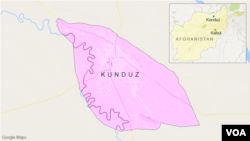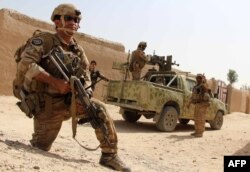Afghan security forces have pushed back the Taliban to the edges of the northern city of Kunduz, a day after the insurgents fought their way into the provincial capital and briefly captured parts of it.
The hostilities come as Afghanistan’s international partners meet in Brussels Tuesday to seek fresh funds to sustain reconstruction efforts in the war-ravaged country at least until 2020 amid renewed calls for seeking a peaceful resolution to the conflict.
Government forces in control in Kunduz
A VOA Afghan service reporter in Kunduz witnessed government forces in control of most of state installations in the city after intense overnight fighting, with provincial authorities urging residents to return to their routines. Doctors in the main regional hospital have told VOA the hostilities caused civilian casualties, but refused to give any figures, saying “we are too busy to save lives, but you are welcome to count them.”
Defense Ministry spokesman Dawlat Waziri told a news conference in Kabul Tuesday that a security operation is currently underway to clear Kunduz of any militant pockets.
“Security forces are moving with utmost care against remaining groups [of the Taliban], who are hiding in civilian houses, to surround them to take them out in a way that no harm is done to to civilians or their residences,” Waziri said.
Fighting in the northern city erupted Monday after Taliban rebels staged a pre-dawn multi-pronged offensive and forced their way deep into the city to raise their white flag on the central square of Kunduz, which briefly fell to the Islamist insurgency in September, 2015.
Both sides have claimed to have inflicted heavy casualties on the opposition and it was not possible to independently verify the claims made by either side.
The U.S. military said Monday it was closely monitoring the situation in Kunduz and had positioned its airpower to assist Afghan forces if needed.
Taliban offensive in the south
Meanwhile, officials in the southern Helmand province say heavy fighting was raging in the districts of Khanshin and Nawa after the Taliban overnight renewed its offensive in their bid to overrun them.
The latest insurgent assaults on Kunduz and Taliban territorial advances near the provincial capitals of Helmand and Uruzgan province in the south have once again exposed weaknesses in the internationally-trained Afghan security force and underlined the rebel group’s growing strength.
Afghan conference in Brussels
The Afghan leadership is co-hosting the two-day Brussels conference with the European Union to emphasize the need for international donors to provide financial assistance to help their country overcome daunting security, economic and human development challenges.
Foreign ministers of the United States, Russia, Iran, China, as well as India and Pakistan are expected to be among representatives from around 70 countries at the conference.
"We're buying four more years for Afghanistan," EU Special Representative for Afghanistan Franz-Michael Mellbin told Reuters. But he stressed that the conference would also seek "a realistic timeline" for a new peace process.
"If we don't achieve peace, it's simply going to be extremely costly for the foreseeable future,” noted Mellbin.
Afghan President Ashraf Ghani is expected to present a deal with the second largest Afghan insurgent group, Hizb-e-Islami, as his government’s significant achievement towards achieving a peaceful end to the conflict. However, there is widespread skepticism because the group’s influence is limited to just a few of the 34 Afghan provinces compared to the Taliban's greater control.











